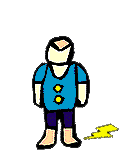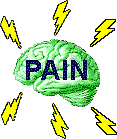 | Kid's
Hurt Too! Study examines frequency and consequences of pain in children |
 February 19, 2005
February 19, 2005Although pain is not a pleasant experience, we need it. Most types of pain tell us that something is wrong and that if we don't do something about it, we might injure ourselves. Pain is common in adults, but how often it occurs in children has not been studied adequately. To investigate pain in children, Dr. Angela Roth-Isigkeit and a team of researchers in Germany and the United States developed a survey for young people. The survey asked 749 children between the ages of 4- and 18-years-old (and some of their parents) about the frequency, intensity, location and duration of pain and whether the pain affected their daily behavior. Pain affected many daily activities of the children. For example, 53.6% of the children reported sleep problems, 53.3% could not participate in hobbies, 51.1% had appetite problems, 48.8% missed school and 46.7% did not meet with their friends because of pain. A variety of conditions were thought to cause pain. A total of 33.0% of the children thought that weather conditions (cold weather) were responsible for their pain. Illness such as a cold (30.7%), sports/physical activities (21.9%), anger (17.6%), lack of sleep (16.2%), and TV/computer use (12.8%) were also said to cause pain. This study shows that pain is problem for many children. The researchers believe that more information about pediatric pain is needed so that parents, teachers and health care workers can effectively treat children who suffer from pain. Prompt treatment of pain may prevent pain from becoming a chronic, long-lasting problem. |
|
References and Links:
|
| BACK TO: | Neuroscience In the News | Table of Contents |
![[email]](./gif/menue.gif) Send |
 Fill out survey |
 Get Newsletter |
 Search Pages |
 Of the 749 children, 622 (83%) of them said that they had experienced pain
within three months of the survey. The most common places the
children had pain were the head (60.5%), abdomen (43.3%), throat (35.5%),
extremities (33.6%) and back (30.2%). Headache pain was the most
bothersome pain for 30.4% of the children. Abdomen pain (12.3%),
extremity pain (10.7%) and back pain (8.9%) were also frequently cited as
bothersome. More than a third (35.2%) of the children said that they had
painful events one or more times each week. Some pain lasted a long time:
9.5% of the children reported that they had pain on and off for more than
three months; 8.7% had pain for more than six months; 22.2% had pain
lasting for more than 12 months!
Of the 749 children, 622 (83%) of them said that they had experienced pain
within three months of the survey. The most common places the
children had pain were the head (60.5%), abdomen (43.3%), throat (35.5%),
extremities (33.6%) and back (30.2%). Headache pain was the most
bothersome pain for 30.4% of the children. Abdomen pain (12.3%),
extremity pain (10.7%) and back pain (8.9%) were also frequently cited as
bothersome. More than a third (35.2%) of the children said that they had
painful events one or more times each week. Some pain lasted a long time:
9.5% of the children reported that they had pain on and off for more than
three months; 8.7% had pain for more than six months; 22.2% had pain
lasting for more than 12 months! About half (50.9%) of the children saw a doctor because of their pain and
51.5% of them took medicine for their pain. Back pain, limb pain and
abdominal pain sent the children to their doctor more often than headache
pain. However, headache pain caused the children to use medicines more
often than back pain, limb pain and abdominal pain.
About half (50.9%) of the children saw a doctor because of their pain and
51.5% of them took medicine for their pain. Back pain, limb pain and
abdominal pain sent the children to their doctor more often than headache
pain. However, headache pain caused the children to use medicines more
often than back pain, limb pain and abdominal pain.